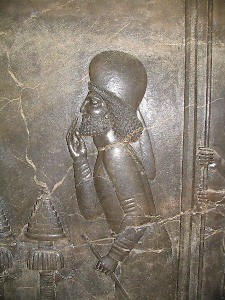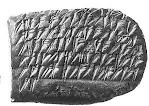Pharnaces (1)
Pharnaces (Elamite Parnaka): founder of the Pharnacid house, mayor of the palace of the Achaemenid king Darius I the Great.

Pharnaces was the son of Arsames, who belonged to the minor branch of the Persian royal family, the Achaemenids; king Cyrus the Great, the founder of the Achaemenid empire, was a very distant relative. When Cyrus defeated the Medes in 550 BCE, Pharnaces must have been fifteen years old (he was a younger brother of Hystaspes, who was born shortly before 565).
Cyrus conquered Babylonia in 539; he appointed Gobryas as his satrap. A cuneiform tablet from Babylon that can be dated in 528 mentions Pharnaces as one of Gobryas' subordinates. He must have been appointed by Cyrus' successor Cambyses.
It is not clear whether Pharnaces was with Cambyses when he invaded Egypt; neither do we know what was his role in the eventful year 522, when a Magian named Gaumâta attempted a coup, Pharnaces' nephew Darius staged a countercoup, and the Achaemenid empire was shattered by civil war (described in the Behistun inscription).
We do know, however, that Pharnaces became one of the most important courtiers: from the Persepolis fortification tablets found at Persepolis, we know that he was the chief economic official of his nephew between 506 and 497. He and his deputy Ziššawiš were responsible for the payments of large quantities of food ('rations') to the Persian grandees.

One example from the Fortification tablets (#798):
130 liters of barley from the possessions of Amavrta have been received by Barîk-'El as his rations. Given in the town of Ithema, in the twenty-first year [of Darius] in the month Shibar [November/December 501].
Other tasks of the mayor of the palace were the issue of passports, the dispatching of judges, accountants, caravans and teams of country laborers. At the same time, Pharnaces was responsible for the collecting of taxes and rents. He also gave orders for payments of silver and gold to the chief treasurer (ganzabara); he survived three of them, Karkish, Šutayauda and (after 495) Baratkâma. In other words, he had very large responsibilities.
He was fittingly rewarded. From the tablets it is clear that a normal Persian laborer was entitled to a ration of one liter of barley every day, which was sufficient to feed a family (although fruits had to be added). Pharnaces, on the other hand, received 180 liters flour, 90 liters wine and two small livestock animals. This was more than he and his household could ever consume and we may assume that nearly all of it was sold. Only Darius' lance carrier Gobryas (not Pharnaces old chief) was entitled to higher rations.
On the picture to the left, we can see Pharnaces doing obeisance to king Darius (proskynesis). His attribute is a short stick, probably made of a precious metal. This sign of the importance of the mayor of the palace was still used in Persia in the seventeenth century CE.

A charming detail from Pharnaces' daily work is known to us from two tablets (#2067 and 2068).
The seal that used to be mine, is now lost. As a substitute, I now use the seal that can be seen in this letter.
Pharnaces was succeeded as chief economic official by Aspathines. Pharnaces had a son Artabazus, who was appointed satrap of Hellespontine Phrygia (northwest Turkey) in 477 and founded a local dynasty that was to rule the satrapy until the fourth century. Probably, the connection between Hellespontine Phrygia and the family dated back to Pharnaces himself, because the Greek philosopher Aristotle of Stagira tells us that Pharnaces showed interest in the mules of Hellespontine Phrygia, and later, the kings of Cappadocia (central Turkey) claimed to descend from Pharnaces.